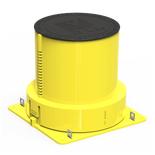Scupper Drain Penetrations and Transitions from Metallic to Plastic Pipe
The increased use of plastic pipe onboard vessels has led to a greater quantity of transitions between metallic pipes and plastic pipes. In no application is this more prevalent than metallic scupper drains, where a section of metallic pipe is affixed to the scupper and transitions to plastic drain pipe (See Figure A).

We understand that certain interpretations of SOLAS suggest that if the metallic pipe affixed to the scupper drain extends 900 mm (≈36”), no protection is required. This interpretation has its roots in the following section, reproduced in its entirety with the pertinent section underlined for convenience.
3 Penetrations in fire-resisting divisions and prevention of heat transmission
3.1. Where “A” class divisions are penetrated, such penetrations shall be tested in accordance with the Fire Test Procedures Code, subject to the provisions of paragraph 4.1.1.5. In the case of ventilation ducts, paragraphs 7.1.2 and 7.3.1 apply. However, where a pipe penetration is made of steel or equivalent material having a thickness of 3mm or greater and a length of not less than 900 mm (preferably 450 mm on each side of the division), and no openings, testing is not required. Such penetrations shall be suitably insulated by extension of the insulation at the same level of the division.
We are of the opinion that metallic pipe to plastic pipe transitions should be protected, regardless of the distance. Our primary concern is that once the plastic pipe is consumed on the fire side, a chimney is created through which flames, smoke, and combustion byproducts can pass freely from deck-to-deck (See Figure B). In a best-case scenario, assuming that flames are unable to physically breach the metallic drain pipe, smoke will still freely bypass the deck, resulting in extensive smoke damage to the space above and potential loss of life due to smoke inhalation. As such, the use of a Transition Firestop Collar is necessary to contain flames and smoke, thereby reducing the risk to both life and property.

Transition Collars are designed to address transitions from metallic to plastic pipe. Intumescent material within these collars will expand at a certain temperature, closing off the melting plastic pipe. The dense char left behind restricts the passage of flames and smoke through the open end of the metal pipe (See Figure C).



























